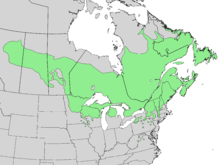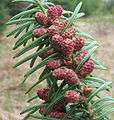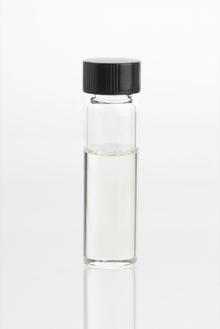Abies balsamea
| Balsam fir | |
|---|---|
 | |
| Tree with cones | |
| Scientific classification | |
| Kingdom: | Plantae |
| Division: | Pinophyta |
| Class: | Pinopsida |
| Order: | Pinales |
| Family: | Pinaceae |
| Genus: | Abies |
| Species: | A. balsamea |
| Binomial name | |
| Abies balsamea | |
 | |
| Range | |
| Synonyms[2] | |
| |
Abies balsamea or balsam fir is a North American fir, native to most of eastern and central Canada (Newfoundland west to central Alberta) and the northeastern United States (Minnesota east to Maine, and south in the Appalachian Mountains to West Virginia).[3]
It is celebrated for its rich green needles, natural conical shape, and needle retention after being cut, and it is notably the most fragrant of all Christmas tree varieties.
Description
Balsam fir is a small to medium-size evergreen tree typically 14–20 metres (46–66 ft) tall, occasionally reaching a height of 27 metres (89 ft). The narrow conic crown consists of dense, dark-green leaves. The bark on young trees is smooth, grey, and with resin blisters (which tend to spray when ruptured), becoming rough and fissured or scaly on old trees. The leaves are flat and needle-like, 15 to 30 mm (5⁄8 to 1 1⁄8 in) long, dark green above often with a small patch of stomata near the tip, and two white stomatal bands below, and a slightly notched tip. They are arranged spirally on the shoot, but with the leaf bases twisted so that the leaves appear to be in two more-or-less horizontal rows on either side of the shoot. The needles become shorter and thicker the higher they are on the tree. The seed cones are erect, 40 to 80 mm (1 1⁄2 to 3 1⁄4 in) long, dark purple, ripening brown and disintegrating to release the winged seeds in September.
 Bark
Bark.jpg) Leaves (needles) on symmetrical branchlets
Leaves (needles) on symmetrical branchlets Closeup of thickly leaved branchlets
Closeup of thickly leaved branchlets Pollen cones
Pollen cones
Varieties
There are two varieties:
- Abies balsamea var. balsamea (balsam fir) – bracts subtending seed scales short, not visible on the closed cones. Most of the species' range.
- Abies balsamea var. phanerolepis (bracted balsam fir or Canaan fir) – bracts subtending seed scales longer, visible on the closed cone. The southeast of the species' range, from southernmost Quebec to West Virginia. The name Canaan fir derives from one of its native localities, the Canaan Valley in West Virginia. Some botanists regard this variety as a natural hybrid between balsam fir and Fraser fir (Abies fraseri), which occurs further south in the Appalachian mountains.
Ecology
Balsam fir tends to grow in cool climates, ideally with a mean annual temperature of 40 °F (4 °C), with consistent moisture at its roots. They typically grow in the following four forest types:
- Swamp - swamp forest types never completely dry out, so balsam firs have constant access to water. The ground is covered in sphagnum and other mosses. In swamps, balsam firs grow densely and slowly, and are slender.
- Flat - sometimes referred to as "dry swamps," these areas are better drained than swamps but still retain moisture well. Fern moss covers the ground and there is a possibility of ground rot. In flat areas balsam fir grows fast, tall, and large, mixed with red spruce.
- Hardwood slope - ground rot is common in this well drained area and leaf litter covers the forest floor. Balsam firs grow fast, tall and large along with big hardwood trees such as yellow birch, sugar maple and beech.
- Mountain top - On mountain tops, stands of balsam fir occasionally develop fir waves. They often grow at an elevation of 2,500 to 3,000 feet in pure strands, or in association with black spruce, white spruce and trembling aspen. The development is similar to that in swamps with slow growth resulting in slender, short trees. Some of the low branches touch the ground, and may grow roots to produce an independent tree.[4]
This tree provides food for moose, American red squirrels, crossbills and chickadees, as well as shelter for moose, snowshoe hares, white-tailed deer, ruffed grouse and other small mammals and songbirds. The needles are eaten by some lepidopteran caterpillars, for example the Io moth (Automeris io).
Life cycle
The male reproductive organs generally develop more rapidly and appear sooner than the female organs. The male organs contain microsporangia which divide to form sporogenous tissue, composed of cells which become archesporial cells. These develop into microspores, or pollen-mother cells, once they are rounded and filled with starch grains. When the microspores undergo meiosis in the spring, four haploid microspores are produced which eventually become pollen grains. Once the male strobilus has matured the microsporangia are exposed at which point the pollen is released.
The female megasporangiate is larger than the male. It contains bracts and megasporophylls, each of which contains two ovules, arranged in a spiral. These then develop a nucellus in which a mother cell is formed. Meiosis occurs and a megaspore is produced as the first cell of the megagametophyte. As cell division takes place the nucleus of the megaspore thickens, and cell differentiation occurs to produce prothallial tissue containing an ovum. The remaining undifferentiated cells then form the endosperm.
When the male structure releases its pollen grains, some fall onto the female strobilus and reach the ovule. At this point the pollen tube begins to generate, and eventually the sperm and egg meet at which point fertilization occurs.[5]
Uses

Both varieties of the species are very popular as Christmas trees, particularly in the northeastern United States. Contrary to popular belief the balsam firs cut for Christmas are not taken from the forest, but are grown on large plantations. The balsam fir is one of the greatest exports of Quebec and New England.
Many of these plantations are family farms handed down from generation to generation. The techniques of shearing, growing, and other cultivation secretly passed down from grandparents to grandchildren. Families like the Rousseau's of Quebec, Rose of New Brunswick, and Kessler's (North Pole Xmas Trees) of New Hampshire have kept family traditions for almost a century.
The resin is used to produce Canada balsam, and was traditionally used as a cold remedy and as a glue for glasses, optical instrument components, and for preparing permanent mounts of microscope specimens. Given its use as a traditional remedy and the relatively high ascorbic acid content of its needles, historian Jacques Mathieu has argued that the balsam fir was the "aneda" that cured scurvy during the second expedition into Canada of Jacques Cartier.[6] The wood is milled for framing lumber (part of SPF lumber), siding and pulped for paper manufacture. Balsam fir oil is an EPA approved nontoxic rodent repellent. The balsam fir is also used as an air freshener and as incense.[7]
Prior to the availability of foam rubber and air mattresses, balsam fir boughs were a preferred mattress in places where trees greatly outnumbered campers. Many fir limbs are vertically bowed from alternating periods of downward deformation from snow loading and new growth reaching upward for sunlight. Layers of inverted freshly cut limbs from small trees created a pleasantly fragrant mattress lifting bedding off the wet ground; and the bowed green limbs were springs beneath the soft needles. Upper layers of limbs were placed with the cut ends of the limbs touching the earth to avoid uncomfortably sharp spots and sap.[8]
The cultivar A. balsamea 'Hudsonia group' (Hudson fir), has gained the Royal Horticultural Society's Award of Garden Merit.[9]
The Native Americans used it for a variety of medicinal purposes.[10]
Cultivars:
- A.b. 'Angustata'
- A.b. 'Argentea'
- A.b. 'Brachylepis'
- A.b. 'Coerulea'
- A.b. 'Columnaris'
- A.b. 'Glauca'
- A.b. 'Globosa'
- A.b. 'Longifolia'
- A.b. 'Lutescens'
- A.b. 'Macrocarpa'
- A.b. 'Marginata'
- A.b. 'Nana'
- A.b. 'Nudicaulis'
- A.b. 'Paucifolia'
- A.b. 'Prostrata'
- A.b. 'Pyramidalis'
- A.b. 'Variegata'
- A.b. 'Versicolor' [11]
Tree emblem
Balsam fir is the provincial tree of New Brunswick.
Pests
The balsam fir is the preferred main host of the eastern spruce budworm, which is a major destructive pest throughout the eastern United States and Canada.[12] During cyclical population outbreaks, major defoliation of the balsam fir can occur, which may significantly reduce radial growth.[13] This can kill the tree. An outbreak in Quebec in 1957 killed over 75% of balsam fir in some stands.[14]
See also
References
- ↑ Farjon, A. (2013). "Abies balsamea". The IUCN Red List of Threatened Species. IUCN. 2013: e.T42272A2968717. doi:10.2305/IUCN.UK.2013-1.RLTS.T42272A2968717.en. Retrieved 10 January 2018.
- 1 2 "Abies balsamea". World Checklist of Selected Plant Families (WCSP). Royal Botanic Gardens, Kew. Retrieved 12 Oct 2016 – via The Plant List.
- ↑ "PLANTS Profile for Abies balsamea (balsam fir)". USDA PLANTS. Retrieved August 21, 2016.
- ↑ Zon, Raphael (March 25, 1914). "Balsam Fir". Bulletin of the U.S. Department of Agriculture. 55: 2–7.
- ↑ Bakuzis, E.V.; Hansen, Henry L.; Kaufert, Frank H. (January 1965). Balsam Fir: A Monographic Review. Minneapolis: University of Minnesota Press. pp. 2, 8–14. ISBN 9780816661282.
- ↑ Mathieu, Jacques. L'Annedda: L'arbre de vie (Quebec: Septentrion, 2009).
- ↑ "Balsam fir oil (129035) Fact Sheet". Archived from the original on December 11, 2008. Retrieved August 21, 2016.
- ↑ Thoreau, Henry David The Maine Woods Apollo edition (1966) Thomas Y. Crowell Company
- ↑ "RHS Plant Selector Abies balsamea Hudsonia Group AGM / RHS Gardening". Apps.rhs.org.uk. Retrieved August 21, 2016.
- ↑ "Abies balsamea". Retrieved August 21, 2016.
- ↑ http://site.ebrary.com/lib/umich/reader.action?docID=10231274}
- ↑ "Out Of Print : Biosystematic Studies of Conifer-Feeding Choristoneura (Lepidoptera Tortricidae) in the Western United States : Edited by Jerry A. Powell - University of California Press". www.ucpress.edu. Retrieved 2017-10-23.
- ↑ Blais, J.R. 1958b. The vulnerability of balsam fir to spruce budworm attack in northwestern Ontario, with special reference to the physiological age of the tree. For. Chron. 34(4):405–422.
- ↑ Blais, J.R.; Martineau, R. 1960. A recent spruce budworm outbreak in the lower St. Lawrence and Gaspé Peninsula with reference to aerial spraying operations. For. Chron. 36(3):209–224.
Further reading
- Hunt, Richard S. (1993). "Abies balsamea". In Flora of North America Editorial Committee. Flora of North America North of Mexico (FNA). 2. New York and Oxford – via eFloras.org, Missouri Botanical Garden, St. Louis, MO & Harvard University Herbaria, Cambridge, MA.
External links
| Wikimedia Commons has media related to: |
| Wikispecies has information related to Abies balsamea |
- Gymnosperm Database: Abies balsamea
- Karen Legasy, Shayna LaBelle-Beadman & Brenda Chambers. Forest Plants of Northeastern Ontario. Lone Pine Publishing / Queen's Printer for Ontario, 1995.
- Winter ID pictures
- Compiled images
- Interactive Distribution Map of Abies balsamea
